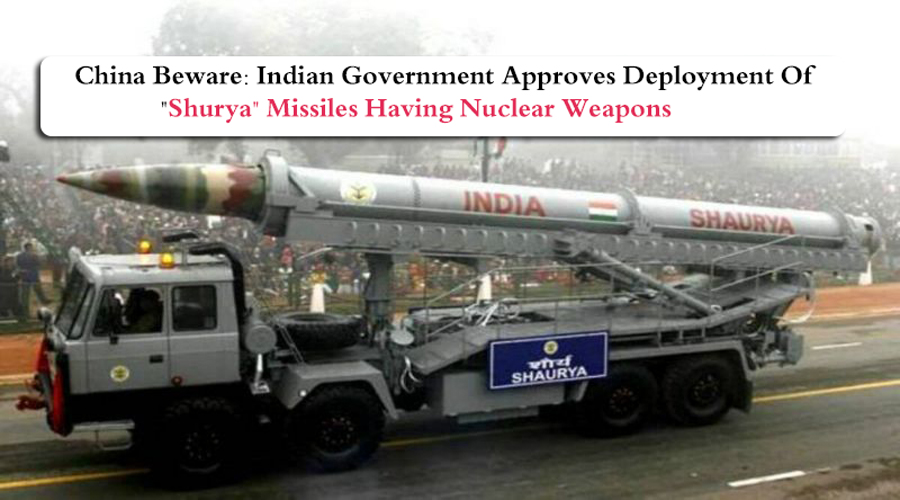
The Narendra Modi government has approved successfully and quietly induction and deployment of surface-to-surface supersonic 700 km range Shaurya Strategic missile even as a forward movement has been recorded in the development of 5,000 km range and K-5 submarine-launched ballistic missile. Shaurya is basically a land version of the submarine-launched B1-05 missile and yes it also has been developed by the keen Defense Research as well as Development Organization. The land version was unnoticeably tested for the last and final time before the induction as part of the user trials in the Balasore of Odisha on October 3.
As per the top missile experts, Shaurya is an outstanding delivery system that is stored in a composite canister for the speedy development as well as minimum interactions with the elements for a long time period. The strategic missile files have the supersonic speed of Mach 7 or 2.4 km per second and at a height of 50 Km within the atmosphere and hit the chosen targeted at Mach 4.
The missile will be deployed soon at the locations examined by the Strategic Forces Command of India under the guidance from the National Security Council. The missile has a weapon that weight across 160 kg. Although the decision of the Modi Government to go for a land version is important as the missile can be launched just by a single vehicle, the DRDO is also making quick strides in the enlargement of a 5,000 km version of the submarine-launched airborne missile the K-5 will be organized on Arihant class of nuclear submarines.
While missile scientists are secretly revealed about the K-5 SLBM, the weapon system is expected to be tested in the next 15 months and after that deployed on the 6,000-tonne Arihant class of SSBNs. The second Arihant-class nuclear-powered submarine, INS Alright, is to be operationalized within the next six months.
The following testing of the hypersonic missile, Shaurya missile, and the supersonic missile helped the release of torpedo by DRDO from Balasore are clear signals from the government to the adversary of the Country that India won’t intimidate down to any compulsion. The 800 km-range subsonic Nirbhay voyage missile will be tested in the next two coming weeks and will be invested into the Indian Navy and Army. The tactical missile already has been deployed in a limited number in the response to the Chinese build-up in Xinjiang and Tibet.
Coming at a time while India is indulged with a belligerent Chinese Army in the Ladakh sector, an official of senior government said the testing and disposition of short-range delivery platforms convey very clearly the Government of Modi intention of not backing down to any violence or cartographical expansion plan of any neighborhood adversary.
It is blemished with a special canister that is made of composite fiberglass and high-pressure gases are used for this. The missile fuel is after that explodes and gains momentum. The function of this gas maker is widely important for the successful launch of the missile. If this system fails to do the job, many systems can explode. Hence, it has maintained 99.997% of accuracy. The technology has been established by the High Energy Materials Research Laboratory in Pune.
Under the direction of the National Security Council, valiant missiles will quickly be deployed at areas that are recognized by the Indian Strategic Forces Command. The nuclear-ability missile is capable of carrying 160 warheads.
Strategic Importance of SLBMs
- The ability to be capable to launch nuclear weapons Submarine platforms have excellent strategic importance in achieving the context of a nuclear triad, specifically in the light of the “no first use” Indian Policy.
- The sea-based underwater nuclear-capable properties importantly increase the second strike ability of a country and therefore, enhances its nuclear dissuasion.
- These Submarines cannot only survive the first strike by the challenger but can also launch a strike in revenger therefore achieving Credible Nuclear Limitation.
- The development of these abilities is significant in the light of relations of India with the two neighbors Pakistan and China
Shaurya Missile
- Shaurya is a land variant of short-range Submarine Launched Ballistic Missile K-15 Sagarika, that has a range of 150 KM.
- It is a surface-to-surface tactical missile and capable of carrying payloads of 200 kg to 1000 kg.
- These ballistic missiles belong to the K missile family and codenamed after late Dr. APJ Abdul Kalam that is launched from Arihant class of the nuclear submarines
- The missile is less vulnerable to anti-airborne missile defense systems because of high maneuverability
- Shaurya such as many of the modern missiles, is a canister-based system, means that is operated and stored from the specially designed compartments under strict guidance
India could develop hypersonic cruise missiles powered by the air-breathing scramjet engines in about four years.







